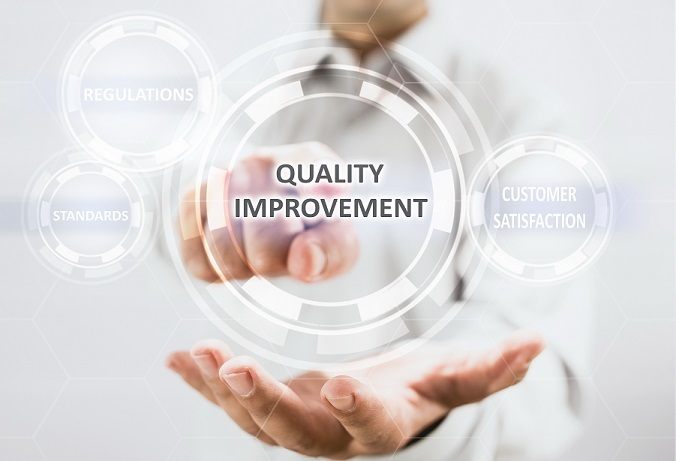Tag Archives for " healthcare safety "

How Excellent Patient Care Saves Costs
Patient Safety is defined as “the absence of preventable harm to a patient and reduction of risk of unnecessary harm associated with health care to an acceptable minimum.” Every hospital in America has a stated mission to prioritize Patient Safety above all else. “First, do no harm” is the most fundamental principle of any health care service. Every healthcare organization says it, but are they really doing everything they can to prioritize patient safety?
The first step to solving a problem is admitting that you have one. But what if you aren’t aware that you have a problem? Especially in the Critical Access and Community Hospital space, where staff is stretched to non-optimal lengths, how can a facility, not only stay on top of patient safety, but take the time necessary to rigorously evaluate processes and policies to improve their quality of care?
Beyond the moral and ethical obligation to provide the best health care possible, there are clear financial benefits, although often unrecognized, unknown, or undervalued, to doing no harm. When was the last time you truly evaluated your facilities process of minimizing risk events, and optimizing quality outcomes? Could it be improved upon? Can it make your facility more profitable? The answer is a resounding yes.
Look at your patient fall data to see how much you’ve paid for Cost of Harm falls last year – what else could your hospital have used that money for? Next time you need to tighten your budget, remember cost cuts don’t just come from lowering staffing or standards. You can also save by minimizing how much quality and risk incidents are costing your hospital.
We’ve found this is true amongst our customers. Using ActionCue© CI’s Performance Improvement Plans and the guidance of our Implementation & Support team, one of our customer hospitals reduced falls at their facility by 25% over three years. Based on the Center of Disease Dynamic’s Cost of Harm figures, this saved them almost a million dollars in additional costs.
Another hospital saved more than a million dollars over three years as their CLASBI cases reduced by almost 47%. A third hospital saved more than $80,000 by cutting their rate of VAP cases by 66% in three years of using ActionCue CI.
Improving the quality of care, through proactively tracking and tackling risk and quality incidents can lead to significant savings from the cost of harm avoided – money that can fund additional staff, equipment upgrades and other improvements.
This positive cycle can multiply – every dollar saved by avoiding a Cost of Harm event can be spent on further eliminating Cost of Harm events, leading to more savings from the cost of harm avoided. As the cycle continues, avoidable costs decrease while the quality of care – and your reputation – increases.
This article first appeared in the March 2024 edition of Marketplace, the monthly newsletter of TORCH Management Services, Inc.

Quality Improvement Performance Indicators: Prioritizing Your Data
In a recent blog post, the Center for Improvement in Healthcare Quality shed some light on an area of concern for many hospitals: the prioritization of data collection within their QAPI program. Hospitals are constantly working to monitor, report on and improve patient safety and quality of care, many of them collecting data on hundreds of performance indicators, but it’s impossible to monitor every single area.
This is where prioritization of data collection comes into play. The Centers for Medicare and Medicaid Services expects hospitals to prioritize high-risk, high-volume or problem-prone areas, but unfortunately, the agency is not specific on what areas qualify as such. However, the CIHQ suggests prioritizing performance indicators that are frequently cited for not being incorporated into a hospital’s QAPI program, such as:
Medication Use
- Sterile Compounding and IV Admixture
- Management of Hazardous Medications
- Medication Administration Practices for High-Risk Meds
Infection Prevention & Control
- Sterilization of Instruments & Supplies
- High-Level Disinfection of Instruments & Supplies
- MDRO and Isolation Practice
- Disinfection and Cleaning of Dialysis Machines & Equipment
Physical Environment
- Environmental Controls of Sensitive Areas (Temperature, Humidity, Air Balance)
- Maintenance and Operation of Critical Medical and Utilities Equipment
- Life Safety System Testing and Maintenance
- Implementation of Interim Life Safety Measures
- Protection Against Radiation Hazards
Food & Nutritional Services
- Food Service Preparation, Storage, and Cleanliness
Clinical Services
- Ordering Restraint & Seclusion
- Monitoring of Patients in Restraint & Seclusion
- Administration of Blood & Blood Products
- Protection of Patients at Risk of Self-Harm
- Administration of Sedation / Anesthesia
- Surgical and Invasive Procedures
While we support CMS and CIHQ in urging focus on certain performance indicators when a limited number can be tracked and addressed, hospitals should be very careful about reducing the number of tracked indicators due to time and resource constraints, because that could potentially have a damaging effect on the organization. The motivation to do so is often present and understandable, when hospitals are utilizing inefficient and labor-intensive performance tracking processes and tools. This is precisely the fundamental issue that Prista’s ActionCue CI application was designed to address.
ActionCue CI is your Fast Path to Insight™, monitoring all 19 performance indicators listed above and more, right out of the box. Its intuitive online dashboards provide critical QI/PI information to those who need it, when they need it. With gains in efficiency and productivity from using ActionCue CI, staff can carry out the quality, safety and improvement activities of the hospital, and cover and drive improvement on a larger number of measures, reducing the chances of being blindsided by a clinical performance issue or a derogatory survey finding.
In addition to comprehensive and efficient data collection, ActionCue helps hospitals take real actions to improve patient care, allowing staff to quickly investigate event causes and manage corrective actions through electronic event reporting. Many hospitals see significant increases in staff participation, communication and cooperation.
While it’s certainly important to take all necessary steps to avoid a CMS citation, ActionCue helps hospitals take quality and performance improvement a step further by truly creating a “Culture of Quality,” representing a collective and sustained commitment by organizational leaders to emphasize safety every single day.

Is Your Quality-Safety System Really a Do-it-Yourself Project? Should it be?
We frequently describe ActionCue Clinical Intelligence as redefining and facilitating the management process for quality-safety improvement. Understanding that taking on quality-safety improvement can bring some apprehension, we want to make clear that we do this to bring a radical increase in efficiency to the process of improving patient care delivery for clinical staff, managers and executives.
Whether a facility or system’s solutions for quality and safety management, tracking, and reporting consists of paper and Excel spreadsheets, internally developed systems, or commercial applications, most of those scenarios have something in common: They require clinical management to spend a good bit of time on manual work. This can include:
- Researching required performance measure definitions and their application within the facility
- Setting the structure of criteria, measures, reports, graphs and notifications within the system
- Entering, manipulating and checking data multiple times as it moves from safety tools and organizations to the quality management arena, and on to the places, tools, and people involved in performance improvement and management information systems
- Creating and executing the mechanisms for communication and collaborating with various staff to carry out multiple fractured workflow processes
- Producing forms, diagrams and other artifacts, the primary purpose of which is to demonstrate adherence to the chosen process and methodology
- Using additional tools, systems or steps to produce static reports in a variety of formats for management review meetings
- Revising and re-doing much of the above repeatedly in response to changing external reporting requirements, additional or revised inquiries, recurring meetings, staff turnover, etc.
It should be noted that in many cases, a good bit of that manual work could be done by administrative workers but is too interwoven in the clinical and quality-safety work to hand it off without major disruption in productivity. In other cases, it requires the clinical professionals to develop skills in information technology and data manipulation that should arguably not be required of them. Both of these instances seriously dilute the application of their best skills, education and professional abilities to improving quality-safety.
Unfortunately, many clinical managers and their senior management accept this kind of manual effort, and the resources it consumes, as the norm for working in quality, safety and improvement. Some believe it is the only way for solutions to work exactly as they want. Even by turning to multiple commercial software vendors, much of this same function building is required as the vendor happily customizes their product and charges significantly for it both upfront and on a continuous basis, while tying up hospital staff in planning and reviewing the customization. After-sale charges can even become the vendor’s primary business model. At Epic Systems’ User Group Meeting in September of 2016, CEO Judy Faulkner said she identifies Epic as a programming shop. The company spends just over 50 percent of operating expenses on research and development each year. With that perspective, how likely is it that such a vendor is going to make the application itself match the needs of its users, or reduce the work of installation, amount of training needed, or degree to which the vendor’s billable time is needed for ongoing administration and updates?
Costs that may be dispersed into the operating budget are often “hidden,” but really add up when considering the Total Cost of Ownership (TCO) for the solution. Almost all of this fits into the “administrative overhead” component of healthcare costs, which is understood by most in the C-suite of hospitals today to be increasing disproportionately.
Once this “build our own” mentality sets in, inertia takes hold. It is common for quality and safety solution acquisitions to focus on one of these “toolkits,” or basic products needing customization that lasts months after purchase. Over time, the organization feels as if it has invested so much into their status quo solution that they certainly don’t want to make a substantial change and start the process all over again. This is especially true when it could impact the many overt work processes in which they have also invested time, money and training.
Many managers initiating searches for quality and safety management solutions may not realize that a well-designed “turnkey” application—embodying not only effective technology but also expertly-crafted healthcare operational design—can be configured in days, not months, to fit their organizations and operations, and similarly be reconfigured to match their evolving needs. While turnkey applications such as ActionCue may be uncommon in healthcare IT, distancing the organization from the practice of costly extensive internal or vendor-teamed software development is something companies in almost all other verticals have done over the years. Although this requires some adjustment in perspective when reviewing products designed for a large healthcare marketplace, the very common mentality of “doing what you’ve always done” is something healthcare providers can simply no longer afford.
